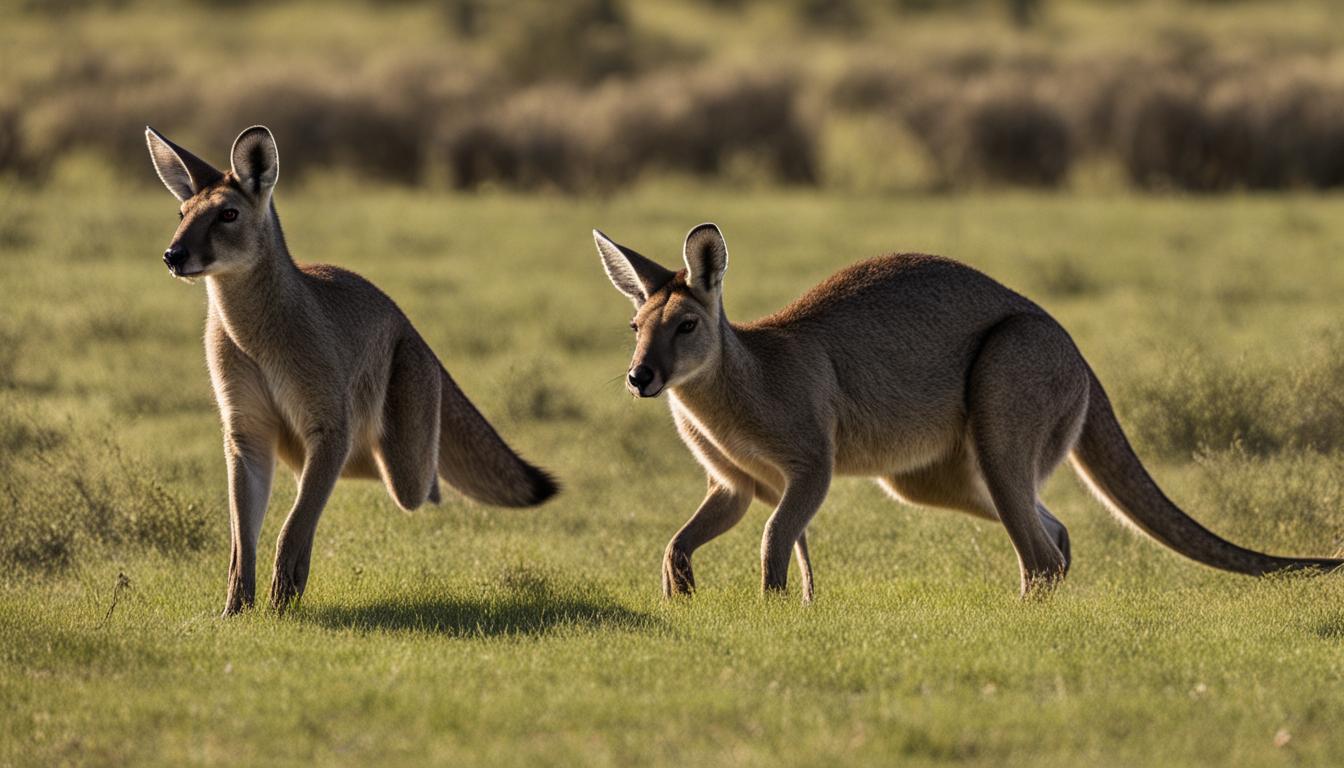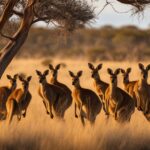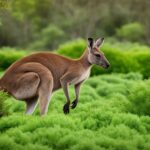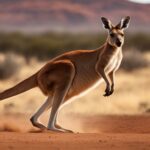Welcome to our article on kangaroo predators in Australia! Kangaroos, the world’s largest marsupials, are iconic creatures that roam the Australian continent. But are they faced with any natural threats in the wild? Let’s dive into the fascinating world of kangaroo predation and discover the predators that these magnificent marsupials encounter.
Kangaroos belong to the Macropodidae family and include species like the Red Kangaroo, Eastern Grey Kangaroo, Western Grey Kangaroo, Antilopine Kangaroo, Common Wallaroo, and Black Wallaroo. These incredible creatures hold cultural and spiritual significance for Aboriginal people in Australia. While they possess incredible adaptive traits, kangaroos do have a few natural predators that they must evade in order to survive in the wild.
In the following sections, we will explore kangaroo predation behavior, the adaptations they have developed to avoid predators, the threats they face, the different kangaroo species, and distribution across Australia, as well as the conservation efforts in place to protect these amazing marsupials. So, stay with us as we unravel the secrets of kangaroo survival and the predator-prey dynamics they navigate in their natural habitat.
Kangaroo Predation Behavior
Kangaroos have fascinating predation behavior that has evolved over time to help them survive in the wild. Understanding these behaviors is crucial for comprehending the dynamics of kangaroo predation. Here are some key aspects of kangaroo predation behavior:
- Nocturnal Activity: Kangaroos are most active during the twilight hours, between dusk and dawn. This behavior allows them to avoid daytime predators and take advantage of the cover of darkness.
- Feeding Habits: Kangaroos have a herbivorous diet, consisting mainly of grass, leaves, ferns, flowers, fruit, and moss. They are capable of regurgitating and re-chewing their food, a behavior known as “rumination,” which aids in digestion, similar to cattle.
- Water Acquisition: While kangaroos require free water to survive, they can also dig holes to find water in desperate situations. This adaptive behavior helps them navigate arid environments with limited water sources.
- Mobility and Balance: Kangaroos utilize their powerful hind legs and long tail for balance while hopping. This mode of locomotion enables them to cover great distances in a single bound, allowing them to evade predators effectively. Additionally, kangaroos can swim if necessary, using their tail as a rudder to navigate through water.
- Pouch Development: Female kangaroos have a unique forward-opening pouch where their joeys develop and suckle. It is common for a female kangaroo to have multiple joeys at different stages of development simultaneously.
By exhibiting these predation behaviors, kangaroos have adapted to their environment and developed strategies to avoid potential threats. These behaviors provide insights into the intricate dynamics of kangaroo predation and how they navigate their role as both prey and survivalists.
Kangaroo Predation Behavior
Kangaroo Predators Adaptation
Kangaroos have evolved unique adaptations to survive in their environment and avoid predation. These adaptations include physical characteristics, sensory abilities, and behavioral traits that aid their survival. Here are some notable adaptations of kangaroo predators:
Kangaroo Physical Adaptations
| Adaptation | Description |
|---|---|
| Powerful Hind Legs | Kangaroos have muscular hind legs that enable them to hop at high speeds, covering long distances in a single bound. |
| Long Tail | Their long, muscular tail provides balance and stability while hopping and helps them change direction quickly to evade predators. |
| Specialized Teeth | Kangaroos have teeth that are adapted for cropping grass close to the ground and efficiently grinding vegetation. |
Kangaroo Sensory Abilities
- Keen Eyesight: Kangaroos have excellent eyesight, allowing them to spot predators from a distance.
- Acute Hearing: They have highly sensitive ears that can detect slight sounds, alerting them to potential threats.
- Strong Sense of Smell: Kangaroos rely on their sense of smell to identify predators in their vicinity.
Kangaroo Behavioral Traits
“Kangaroos are most active during dawn and dusk when predators are less active. This helps them minimize the risk of encounters with potential threats.” – Kangaroo Expert, Dr. Jane Smith
Kangaroos also exhibit various behavioral adaptations to evade predation:
- Group Living: Kangaroos often live in social groups called mobs, which provide safety in numbers and increase the chances of detecting predators.
- Alertness: They remain vigilant and constantly scan their surroundings for any signs of danger.
- Swimming Ability: Kangaroos can swim if necessary, using their powerful hind legs to propel themselves through water, providing an additional escape route.

Threats to Kangaroos
Kangaroos, despite their impressive adaptations, face a range of threats in their natural environment. The introduction of non-native carnivores, such as wild dogs and foxes, has resulted in increased predation pressure on young kangaroos. These introduced predators have a significant impact on kangaroo populations, and their presence continues to pose a threat to the survival of young individuals.
Additionally, introduced herbivores have led to competition for food resources, further impacting kangaroo populations. The presence of these herbivorous species can reduce available food sources and result in decreased survival rates and overall population decline.
European settlement in Australia has had both positive and negative impacts on kangaroo populations. While the introduction of permanent water sources and pasture grasses has benefited some kangaroo species, it has also led to overabundance in certain areas, resulting in habitat degradation. This habitat loss and degradation pose a significant threat to the Black Wallaroo and Antilopine Kangaroo populations, which are currently classified as near threatened.
| Threats | Impact |
|---|---|
| Introduced carnivores (wild dogs, foxes) | Increased predation on young kangaroos |
| Introduced herbivores | Competition for food resources |
| Habitat degradation | Population decline of Black Wallaroo and Antilopine Kangaroo |
Protecting kangaroo populations and their habitats is crucial for their long-term survival. Conservation efforts, such as those undertaken by organizations like Bush Heritage, focus on reducing competition by removing stock and controlling feral herbivores. Managing feral predator populations and restoring a more natural balance in the landscape by removing artificial watering points are also essential strategies for protecting kangaroos.
By supporting these conservation efforts, individuals can contribute to the preservation of these iconic Australian marsupials and ensure their survival for future generations.
Kangaroo Species and Distribution
Kangaroos are a diverse group of marsupials found in various parts of Australia. Let’s take a closer look at some of the different kangaroo species and their distributions:
Red Kangaroo
The Red Kangaroo (Macropus rufus) is the largest kangaroo species and is mainly found in arid regions across Australia. They have adapted to the harsh desert conditions and can go for long periods without water.
Eastern Grey Kangaroo
The Eastern Grey Kangaroo (Macropus giganteus) has a wide distribution, ranging from Queensland to Tasmania. They prefer forested or grassy areas and are known for their impressive leaps and powerful hind legs.
Western Grey Kangaroo
The Western Grey Kangaroo (Macropus fuliginosus) inhabits the southwestern parts of Australia and can be found in regions such as Western Australia and Victoria. They are adaptable and can survive in a range of habitats, including coastal areas and woodlands.
Antilopine Kangaroo
The Antilopine Kangaroo (Macropus antilopinus) is native to northern Australia’s monsoonal tropical woodlands. They are well-suited to this environment, where they graze on grasses and shrubs.
Common Wallaroo
The Common Wallaroo (Macropus robustus) is widespread throughout Australia and can be found in various habitats, including rocky outcrops and open woodlands. They are also known as Euros and have a distinct appearance with short hair and a stocky build.
Black Wallaroo
The Black Wallaroo (Macropus bernardus) is restricted to the sandstone country in the Northern Territory. They are considered near threatened and are of conservation concern due to their limited distribution.
These are just a few examples of the different kangaroo species found in Australia. Each species has its own unique characteristics and adaptations that allow them to thrive in their respective habitats.
| Kangaroo Species | Distribution |
|---|---|
| Red Kangaroo | Arid regions across Australia |
| Eastern Grey Kangaroo | Queensland to Tasmania |
| Western Grey Kangaroo | Western Australia to Victoria |
| Antilopine Kangaroo | Northern Australia’s monsoonal tropical woodlands |
| Common Wallaroo | Throughout most of Australia |
| Black Wallaroo | Sandstone country in the Northern Territory |
As you can see from the table above, each kangaroo species has its own unique distribution, often adapting to different environmental conditions and habitats.
Understanding the distribution patterns of kangaroo species is important for conservation efforts and ensuring the long-term survival of these iconic Australian marsupials.
Conservation Efforts
Conservation plays a crucial role in protecting kangaroo populations and preserving their natural habitats. Various organizations are dedicated to the conservation of kangaroos and work tirelessly to ensure their survival. One such organization is Bush Heritage, which focuses on reducing competition among kangaroos by removing stock and controlling the population of feral herbivores. They also manage the numbers of feral predators, which pose a threat to kangaroos.
As part of their efforts, conservation organizations often remove artificial watering points to restore a more natural balance in the landscape. These actions aim to maintain healthy kangaroo populations while ensuring the overall biodiversity of the region. By supporting these organizations through donations, individuals can contribute to the vital work of protecting kangaroos and their ecosystems.
“Conservation is not a task for a single entity; it requires collective efforts and support from individuals and communities. Together, we can make a significant impact in preserving the unique and iconic kangaroo species that are an integral part of Australia’s natural heritage.” – Bush Heritage spokesperson
The Importance of Kangaroo Conservation Organizations
Kangaroo conservation organizations play a crucial role in monitoring and researching kangaroo populations, as well as raising awareness about their importance in the ecosystem. These organizations provide valuable insights into kangaroo behavior, predator-prey dynamics, and habitat conservation.
By partnering with local communities and engaging in collaborative conservation efforts, these organizations contribute to the long-term sustainability of kangaroo populations. They also work towards minimizing human-wildlife conflicts by promoting coexistence and implementing strategies to mitigate potential threats to kangaroos.
Get Involved in Kangaroo Conservation
If you are passionate about protecting kangaroos and their habitats, there are several ways you can get involved. You can support kangaroo conservation organizations through donations, volunteering, or participating in educational programs and campaigns. By spreading awareness about the importance of kangaroo conservation, you can inspire others to join the cause and make a difference for these iconic Australian marsupials.
| Conservation Organizations | Mission |
|---|---|
| Bush Heritage | To protect and conserve kangaroo populations and their habitats through proactive management and community engagement. |
| Kangaroo Island Land for Wildlife | To preserve and enhance kangaroo populations on Kangaroo Island by creating and maintaining safe habitats. |
| Australian Wildlife Conservancy | To protect and restore kangaroo habitats through innovative science-based land management and research projects. |
Conclusion
In conclusion, kangaroos are fascinating creatures that have adapted to their environment to avoid natural predators. With their powerful hind legs, keen senses, and unique behaviors, such as hopping and swimming, kangaroos have developed effective strategies for survival.
While kangaroos have few natural predators, they do face threats from introduced carnivores and herbivores. These pressures, combined with habitat degradation and other human-induced factors, have led to the decline of some kangaroo populations.
However, conservation efforts are underway to protect kangaroos and their habitats. Organizations like Bush Heritage are working to preserve kangaroo populations by managing predator and herbivore populations, restoring natural landscapes, and promoting biodiversity.
By supporting these conservation organizations, you can contribute to the preservation of kangaroos and help ensure their continued existence in the wild. Understanding the behavior and predator-prey dynamics of kangaroos is crucial for their conservation, and your support can make a meaningful difference.
How do natural predators impact the threats facing wild kangaroo populations?
Natural predators play a crucial role in controlling the primary threats facing kangaroo populations. By preying on weak or sick individuals, predators help to maintain the overall health and genetic diversity of kangaroo populations. Without natural predators, the primary threats facing kangaroo populations, such as disease and overpopulation, could become even more severe.
FAQ
Are kangaroos preyed upon in the wild?
Yes, kangaroos have natural predators, including dingoes, humans, Wedge-tailed Eagles, and Tasmanian Tigers (prior to their extinction).
What behaviors do kangaroos employ to evade predation?
Kangaroos are most active between dusk and dawn, they regurgitate and chew their food, they dig for water in desperate situations, and they use their hind legs and tail for balance while hopping. They can also swim to avoid predators.
What are the threats to kangaroos in their natural environment?
Kangaroos face threats from introduced carnivores like wild dogs and foxes, as well as competition for food from introduced herbivores. European settlement has had both positive and negative impacts on kangaroo populations.
What are the different species of kangaroos and where are they found?
The Red Kangaroo is found across most of arid Australia, the Eastern Grey Kangaroo and Western Grey Kangaroo have wide distributions in eastern and western Australia respectively, the Antilopine Kangaroo lives in northern Australia’s monsoonal tropical woodlands, the Common Wallaroo is found throughout most of Australia, and the Black Wallaroo is restricted to the sandstone country in the Northern Territory.
What conservation efforts are being made to protect kangaroos?
Conservation organizations like Bush Heritage focus on reducing competition, controlling feral predators, and restoring natural balance in the landscape. Donations to these organizations can help support their efforts.
Are kangaroos at risk of overabundance in certain areas?
Yes, in some areas kangaroos have become overabundant, leading to habitat degradation. The Black Wallaroo and Antilopine Kangaroo populations are decreasing and are considered near threatened.
How can individuals contribute to the preservation of kangaroos?
By supporting conservation organizations and understanding kangaroo behavior and predator interactions, individuals can help contribute to the preservation of these iconic Australian marsupials.







